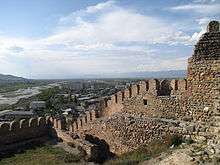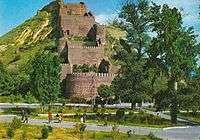Gori Fortress


Gori Fortress (Georgian: გორის ციხე, "Goris Tsikhe") is a medieval citadel in Georgia, standing above the city of Gori on a rocky hill.
The fortress first appears in the 13th century records but archaeological evidence shows that the area had already been fortified in the last centuries BC. The fortress controlled major strategic and economic routes and accommodated a large garrison. In the 16th century the Ottomans captured it to overawe Tbilisi. In 1598 the Georgians besieged it to no avail; in 1599 they feigned a relaxation of the siege for Lent before launching a surprise attack at night to regain the citadel.[1] The fortress continued to change hands between the Georgians and the Persians in the 17th century.
The citadel acquired the present-day form under the Georgian kings Rostom of Kartli in the 1630s and Erekle II in 1774. After the Russian annexation of Georgia in 1801, the fortress was garrisoned by a Russian grenadier battalion, but its importance gradually declined and the fortifications went defunct. The British Encyclopædia Metropolitana reported in 1845:
At the foot of a chain of low sand-stone hills stands the Town and Fortress of Gori, (perhaps the Gursenna of Strabo,) the next place in magnitude and importance to Tiflis. The Castle, an oblong, 200 paces in length, placed sixteen fathoms above the level of the Liakhvi, running at the foot of the hill on which it stands, is now abandoned, a Chapel in its South-Eastern angle being the only part in use.[2]
Gori Fortress was significantly damaged by the earthquake in 1920. The best preserved structure is Tskhra-kara ("the Nine-gated"), which looks to the west, and is adjoined by the supplementary walls on the south and east.
Gallery
 Gori fortress, by Cristoforo Castelli, circa 1642
Gori fortress, by Cristoforo Castelli, circa 1642 Gori Fortress
Gori Fortress-1.jpg) Gates of the fortress
Gates of the fortress Pathway to the fortress
Pathway to the fortress Gori fortress from the north side
Gori fortress from the north side
References
| Wikimedia Commons has media related to Gori fortress. |
Coordinates: 41°59′10″N 44°06′29″E / 41.98611°N 44.10806°E